初一英语上册期末考试知识点总结
七年级上册英语期末

七年级上册英语期末前言本文档旨在总结和回顾七年级上册英语课程的内容,并为期末考试做准备。
通过系统地梳理各个单元的重点内容,帮助同学们更好地理解和掌握英语知识。
本文档包含七年级上册英语课程的重点知识点、必备词汇及语法要点等,供同学们参考。
一、学习目标1.掌握七年级上册英语课程的重点知识点和语法要点;2.熟悉相关课文内容,掌握必备词汇;3.提高听、说、读、写的能力;4.为期末考试做好准备。
二、课程内容回顾1. Unit 1 - Hello本单元主要学习打招呼和自我介绍的基本用语,了解一些国家的名称和语言。
重点知识点:•打招呼和表达身份的用语;•各国名称及其对应的语言。
2. Unit 2 - My School Day本单元主要学习描述日常学校生活的表达方式,如上课、休息和放学等。
重点知识点:•时间和日常活动的表达;•学科名称及其对应的简称。
3. Unit 3 - Hobbies本单元主要学习描述个人爱好和周末活动的表达方式。
重点知识点:•描述个人爱好的常用表达;•描述周末活动的常用表达。
4. Unit 4 - My Family本单元主要学习家庭成员的称呼和家庭成员之间的关系描述。
重点知识点:•家庭成员的称呼;•描述家庭关系的表达方式。
5. Unit 5 - Food and Drinks本单元主要学习食物和饮料的名称和描述。
重点知识点:•食物和饮料的名称;•描述食物和饮料的味道和喜好。
6. Unit 6 - Around Town本单元主要学习城市和交通方式的表达方式,了解一些城市地标。
重点知识点:•城市地标及其位置描述;•交通方式的表达方式。
三、必备词汇下表列出了七年级上册英语课程中的必备词汇。
单元词汇中文意思Unit 1 Hello, Hi, Good morning, Good afternoon, Good evening,Good night打招呼、问候Unit2Class, Art, Music, P.E., Math, Chinese 学科名称Unit 3 Hobby, Swimming, Dancing, Singing, Painting 爱好、周末活动Unit4Family, Mother, Father, Sister, Brother 家庭成员Unit5Food, Drinks, Apple, Banana, Orange 食物、饮料Unit 6 City, Subway, Bus, Park, Hotel 城市、交通方式温馨提示:在背诵词汇时,建议使用单词卡等记忆方法,同时尽量将词汇应用到实际情境中,加深记忆。
七年级英语上册总复习知识点考点总结归纳
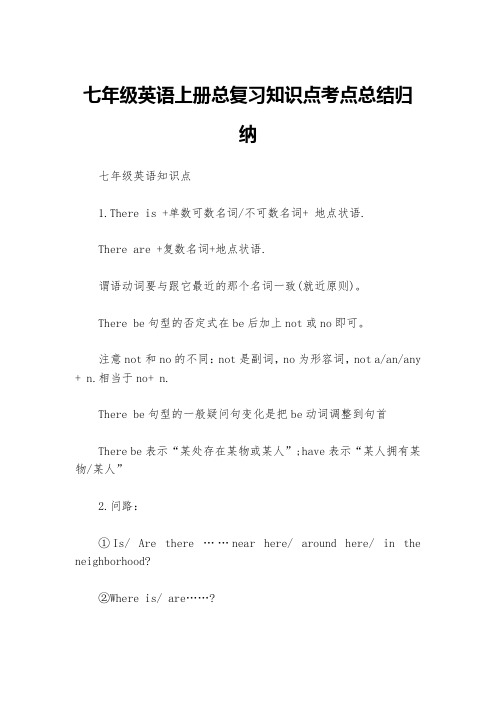
七年级英语上册总复习知识点考点总结归纳七年级英语知识点1.There is +单数可数名词/不可数名词+ 地点状语.There are +复数名词+地点状语.谓语动词要与跟它最近的那个名词一致(就近原则)。
There be句型的否定式在be后加上not或no即可。
注意not和no的不同:not是副词,no为形容词,not a/an/any + n.相当于no+ n.There be句型的一般疑问句变化是把be动词调整到句首There be表示“某处存在某物或某人”;have表示“某人拥有某物/某人”2.问路:①Is/ Are there ……near here/ around here/ in the neighborhood?②Where is/ are……?③How can I get to……?④Could/Can you tell me the way to……⑤Which is the way to……3.Across,cross,through,overAcross是介词,“横过,在对面”表示从物体表面穿过Cross是动词,相当于go/ walk acrossThrough是介词,表示从物体中间或里面穿过 go through the doorOver是介词,“横过,越过”表示从物体上空越过,跨过 fly over4.ask for help/ advice5.in/ on the street6.在某条大街上习惯用介词on on Bridge Street7.across from,next to,between…and…,behind8.in front of在…(外部的)前面→behind在…后面 in the front of在…(内部的)前面9.be in town→be out of town10.be far from11.go/ walk along go straight go up/ down12.turn left/right13.on one’s/ the left14.at the first crossing/ turning15.sometimes 有时(频度副词)sometime(将来)有朝一日,(曾经)某天Some times 几次,几倍 some time 一段时间(前面用介词for) 16.free空闲的 free time自由的 as free as a fish免费的 The best things in life are free.17.enjoy doing18.Time goes quickly.19.表“一些”在肯定句中用some.在疑问句和否定句中用any。
新冀教版七年级上册英语期末复习全册知识点归纳

Unit 1 A Trip to the Silk Road必背单词1. trip n.旅行,旅程→a trip to 一次……的旅行→have /take a trip 旅行2. silk n.丝;丝绸→the Silk Road丝绸之路3. lead v. 带领;指路→led(过去式)→led(过去分词)→leader n. 领导,向导→lead to 引向;通向4. chance n.机会;运气→ take a chance to do sth.抓住机会做某事5. send v.寄;送→sent(过去式)→sent(过去分词)→send sb. sth. 给某人寄某物6. news n. 新闻;消息7. note n. 便笺;笔记8. road n. 路,公路必背短语9. guess what 猜猜看;你猜怎么着10. learn about 学习;了解必背句子11. We're learning about the Silk Road this month in school.在学校我们这个月学习丝绸之路。
12. May I go with them?我可以和他们一起去吗?13. Who will lead the trip?谁将带领这次旅行?必背单词1. exciting adj.使人激动的(用来修饰物)→excited adj.感到兴奋的(用来修饰人)2. along prep.沿着……→walk along 沿着……走3. arrive v.到达,抵达→arrive in 到达(大地点)→arrive at 到达(小地点)4. leave v.动身;出发;离开→left(过去式)→left(过去分词)→leave for sp. 前往某地;动身去某地5. kilometer n. 千米;公里6. special adj.特殊的;特别的必背短语7. plan for the trip 关于旅行的计划8. come back to 回……必背句子9. How exciting!多么令人激动!10. How far is it from Beijing to Xi'an?从北京到西安多远?11. But we don't have enough time to see it all.但是我们没有足够时间去看它的全貌。
关于初一英语上册知识点归纳总结
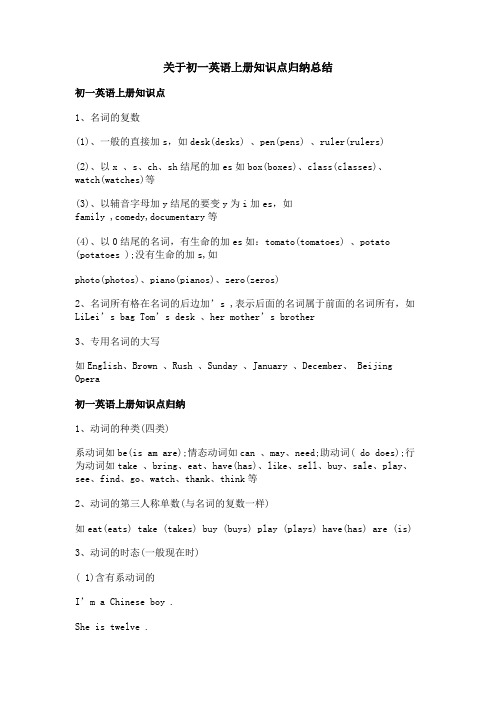
关于初一英语上册知识点归纳总结初一英语上册知识点1、名词的复数(1)、一般的直接加s,如desk(desks) 、pen(pens) 、ruler(rulers)(2)、以x 、s、ch、sh结尾的加es如box(boxes)、class(classes)、watch(watches)等(3)、以辅音字母加y结尾的要变y为i加es,如family ,comedy,documentary等(4)、以0结尾的名词,有生命的加es如:tomato(tomatoes) 、potato (potatoes );没有生命的加s,如photo(photos)、piano(pianos)、zero(zeros)2、名词所有格在名词的后边加’s ,表示后面的名词属于前面的名词所有,如LiLei’s bag Tom’s desk 、her mother’s brother3、专用名词的大写如English、Brown 、Rush 、Sunday 、January 、December、 Beijing Opera初一英语上册知识点归纳1、动词的种类(四类)系动词如be(is am are);情态动词如can 、may、need;助动词( do does);行为动词如take 、bring、eat、have(has)、like、sell、buy、sale、play、see、find、go、watch、thank、think等2、动词的第三人称单数(与名词的复数一样)如eat(eats) take (takes) buy (buys) play (plays) have(has) are (is)3、动词的时态(一般现在时)( 1)含有系动词的I’m a Chinese boy .She is twelve .He is Tim’s brother .Her mother is an English teacher .含有系动词的句子在变一般疑问句时只将“主语和系动词交换位置”,上面句子变成一般疑问句时分别为Are you a Chinese boy ?(注意第一人称通常变为第二人称)Is she twelve ?Is he Tim’s brother ?Is her mother an English teacher ?含有系动词的句子在变否定句时只须“在系动词的后边加上not”,前面的几个了陈述句变否定句分别为I’m not a Chinese boy.She isn’t twelve .He is not Tim’s btother .Her mother isn’t an English teacher .(2)含有情态动词的句子( can ),She can play basketball.His mother’s cousin can sing many English songs.含有情态动词的句子在变一般疑问句时只须将“主语和情态动词交换位置”,上面两句变一般疑问句分别为Can she play basketball ?Can his mother’s cousin sing many English songs ?含有情态动词的句子在变否定句时直接在情态动词的后边加上not ,上面两个陈述句变否定句分别为She can not play basketball .His mother’s cousin can not sing many English songs .(3)含有行为动词的句子We have many friends.They watch TV at 7 in the evening .The students take their books to school .I have lunch at school .You have a sister .1含有行为动词的句子在变一般疑问句时要在原句子的前面加do.上面的句子变成一般疑问句分别为Do you have many friends ?Do they watch TV at 7 in the evening ?Do the students take their books to school ?Do you have lunch at school ?Do you have a sister ?2含有行为动词的句子在变否定句时只须在行为动词前加don’t .上述五个陈述句变否定句分别为We don’t have many friends.They don’t watch TV at 7 in the evening .The students don’t take their books to school .I don’t have lunch at school .You don’t have a sister .3含有行为动词的句子,当主语是第三人称单数时,行为动词要加s (或es)如:She has a red pen .He has eggs for breakfast .Her mother buys a skirt for her .She likes thrillers .My brother watches TV every evening .He wants to go to a movie .含有行为动词的句子,当主语是第三人称单数时,变一般疑问句要“在原句子的前面加上does ,同时行为动词要还原”。
人教版七年级英语上册(部编2023) 期末复习提纲

人教版七年级英语上册(部编2023) 期末复习提纲Unit 1: Greetings and Introductions- Greeting people and responding- Introducing oneself and others- Asking and answering personal information questions- Making simple conversations using greetings and introductionsUnit 2: My Family- Describing family members and their characteristics- Talking about family relationships- Using possessive adjectives to describe family members- Sharing information about one's familyUnit 3: School Life- Talking about daily school routines- Describing classroom objects and places- Discussing subjects and school activities- Expressing likes and dislikes about school lifeUnit 4: Hobbies and Interests- Talking about hobbies and interests- Describing activities related to hobbies- Expressing preferences and opinions about hobbiesUnit 5: Food and Drinks- Describing food and drinks- Talking about likes and dislikes of food- Ordering food and drinks at a restaurant- Expressing preferences for different types of foodUnit 6: Colors and Clothes- Learning different colors in English- Describing clothes and their colors- Talking about clothing preferences and styles- Discussing appropriate clothing for different occasionsUnit 7: Numbers and Telling Time- Learning and pronouncing numbers in English- Talking about dates and birthdays- Telling time and discussing daily schedules- Expressing time using both analog and digital formatsUnit 8: Daily Activities- Discussing daily activities and routines- Talking about leisure activities and free time- Using time expressions to describe daily routinesUnit 9: Places in the City- Describing different places in a city- Giving directions to navigate through a city- Talking about likes and dislikes of places- Discussing activities to do in different locationsUnit 10: Occupations and Aspirations- Learning and pronouncing different occupations- Talking about future aspirations and dreams- Describing job responsibilities and characteristics- Discussing personal interests related to future careersUnit 11: Weather and Seasons- Describing different weather conditions- Talking about seasons and their characteristics- Discussing favorite seasons and weather preferences- Expressing feelings and emotions about the weatherUnit 12: Holidays and Celebrations- Learning about different holidays and celebrations- Describing traditions and customs of specific holidays - Talking about personal experiences during holidays- Expressing wishes and greetings for different occasionsUnit 13: Daily Routines- Talking about daily activities and schedules- Using adverbs of frequency to describe routines- Discussing preferences for different activities- Expressing opinions about daily routinesUnit 14: Health and Body- Describing body parts and their functions- Discussing healthy habits and lifestyle choices- Giving advice for maintaining good healthUnit 15: Shopping- Talking about different types of shops and stores- Describing items for sale and their prices- Discussing shopping preferences and habits- Asking for help and making purchases at a storeUnit 16: Transportation- Learning and pronouncing different modes of transportation - Talking about means of transportation and their features- Describing travel experiences and preferences- Asking for transportation information and directionsUnit 17: Countries and Nationalities- Learning and pronouncing different countries and nationalities - Talking about one's own and others' nationalities- Discussing cultural characteristics and traditionsUnit 18: Daily Life in Different Countries- Learning about daily life customs in different countries- Talking about cultural differences and similarities- Discussing traditional food, clothing, and activities- Sharing personal experiences or knowledge about other countries- Talking about different types of technology and devices- Describing how technology is used in daily life- Discussing advantages and disadvantages of technology- Expressing opinions about technology and social mediaUnit 20: Review and Assessment- Reviewing key vocabulary and grammar points from previous units- Practicing listening, speaking, reading, and writing skills请根据这个提纲来复习人教版七年级英语上册的内容。
七上英语考点归纳

七上英语考点归纳
以下是七年级上册英语的部分考点归纳:
1. 名词:掌握可数名词和不可数名词的区别,掌握名词所有格的构成及使用,以及掌握一些常见的固定搭配和习惯用法。
2. 动词:掌握基本动词的时态和语态(一般现在时、现在进行时、一般过去时、一般将来时),了解动词不定式的用法。
3. 形容词和副词:了解形容词和副词的用法,掌握形容词和副词的比较级和最高级的用法。
4. 介词:了解常用介词的用法,如in、on、at、under等。
5. 句型结构:掌握简单句、并列句和复合句的基本结构,了解宾语从句、定语从句等常见句型结构。
6. 听力理解:能够听懂简单的英语对话和短文,把握关键信息和细节。
7. 口语表达:能够用简单的英语进行日常交流和表达自己的观点。
8. 阅读理解:能够读懂简单的英语文章,理解文章的主旨和细节,并完成相关的阅读理解题目。
9. 写作:能够写简单的英语短文,包括描述、叙述、说明等类型的文章,掌握基本的写作技巧和表达方式。
以上是七年级上册英语的部分考点归纳,需要掌握的词汇和语法知识点较多,建议通过多练习和多使用来加深理解和记忆。
初一英语上册知识点归纳总结

一、be动词的用法be动词有三种变形,分别是:am, is, are。
记忆口诀:“我”用am, “你”用are, is用于“他、她、它”;单数全都用is,复数全部都用are。
二、人称与人称代词的不同形式(主格和宾格)1、三种人称:第一人称(I, we),第二人称(you, you),第三人称(he, she, it, Maria)。
2、人称代词的主格,即人称代词位于句子主语位置时的形态:I, We, You, You, He, She, It, Maria。
3、人称代词的宾格,即人称代词位于句子宾语位置时的形态:me, us, you, you, him, her, it。
4、形容词性物主代词:my, our, your, your, his, her, its, their。
5、名词性物主代词:mine, ours, yours, yours, his, hers, its, theirs。
6、反身代词:myself, ourselves, yourself, yourselves, himself, herself, itself, themselves。
三、基数词(表示数量多少的词,大致相当于代数里的自然数)zero, one, two, three, four, five, six, seven, eight, nine, ten, eleven, twelve, thirteen, fourteen, fifteen, sixteen, seventeen, eighteen, nineteen, twenty, twenty-one, twenty-two,twenty-three,twenty-four, twenty-five, twenty-six, twenty-seven, twenty-eight, twenty-nine, thirty, forty, fifty,sixty,seventy, eighty, ninety, one hundred,one hundred and one。
七年级上册英语知识点归纳总结

七年级上册英语知识点归纳总结一、词汇与短语1. 基本词汇- 问候语:hello, hi, good morning/afternoon/evening- 常见颜色:red, blue, green, yellow, black, white, pink- 数字:one to ten, first to twelfth (for months and dates) - 常见动物:cat, dog, bird, fish, elephant, tiger- 家庭成员:mother, father, sister, brother, grandmother, grandfather2. 学校相关词汇- 学科:English, math, science, history, art, P.E. (physical education)- 学校设施:classroom, library, gym, cafeteria, office- 学习用品:book, pen, pencil, eraser, ruler, backpack3. 日常活动与习惯- 活动:play, read, write, listen, watch, eat, drink- 习惯:brush teeth, wash face, take a shower, go to bed4. 常见食物与饮料- 食物:apple, banana, orange, bread, rice, chicken, fish- 饮料:water, milk, juice, tea, coffee5. 常见形容词- 大小:big, small- 形状:round, square, long, short- 颜色相关:red, blue, green, yellow, etc.- 情感:happy, sad, angry, excited二、语法要点1. 时态- 一般现在时:表示经常发生的动作或状态,使用动词原形。
初一上学期英语知识点总结
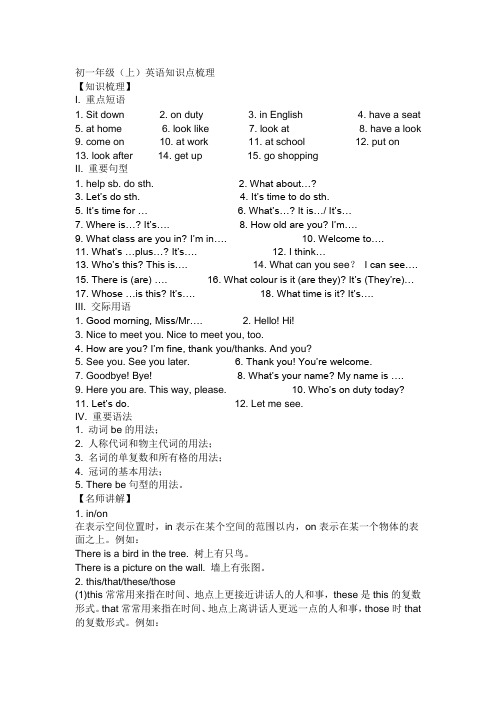
初一年级(上)英语知识点梳理【知识梳理】I. 重点短语1. Sit down2. on duty3. in English4. have a seat5. at home6. look like7. look at8. have a look9. come on 10. at work 11. at school 12. put on 13. look after 14. get up 15. go shoppingII. 重要句型1. help sb. do sth.2. What about…?3. Let’s do sth.4. It’s time to do sth.5. It’s time for …6. What’s…? It is…/ It’s…7. Where is…? It’s…. 8. How old are you? I’m….9. What class are you in? I’m in….10. Welcome to….11. What’s …plus…? It’s….12. I think…13. Who’s this? This is….14. What can you see?I can see….15. There is (are) ….16. What colour is it (are they)? It’s (They’re)…17. Whose …is this? It’s….18. What time is it? It’s….III. 交际用语1. Good morning, Miss/Mr….2. Hello! Hi!3. Nice to meet you. Nice to meet you, too.4. How are you? I’m fine, thank you/thanks. And you?5. See you. See you later.6. Thank you! You’re welcome.7. Goodbye! Bye! 8. What’s your name? My name is ….9. Here you are. This way, please. 10. Who’s on duty today? 11. Let’s do.12. Let me see.IV. 重要语法1. 动词be的用法;2. 人称代词和物主代词的用法;3. 名词的单复数和所有格的用法;4. 冠词的基本用法;5. There be句型的用法。
初一英语上册知识点归纳总结

初一英语上册知识点归纳总结初一英语上册知识点归纳总结一、基本语法知识点:1. 人称代词:I, you, he, she, it, we, they2. 短语:in the morning, in the afternoon, in the evening3. 时态:一般现在时,一般过去时,一般将来时4. 名词的数:单数形式和复数形式的变化规则5. 形容词的比较级和最高级6. 动词的变化规则7. 介词的使用:in, on, at, by, from, to, with, for8. 情态动词:can, could, may, might, must二、常用词汇和短语:1. 数字:one, two, three, four, five, six, seven, eight, nine, ten2. 学科词汇:math, English, Chinese, history, geography, music, art3. 颜色词汇:red, blue, yellow, green, orange4. 时间词汇:today, yesterday, tomorrow, week, month, year5. 日常活动词汇:eat, drink, play, read, write, draw, sing, dance, swim, run, walk, jump6. 祈使句和感叹句的表达:Sit down. Stand up. Thank you. Goodbye. How are you?三、日常用语和表达:1. 问候和道别:Hello. Hi. Good morning. Good afternoon. Good evening. Goodbye. See you. Take care.2. 询问和回答:What's your name? How old are you? Where are you from? How do you do? What do you like? What's this? What's that?3. 请求和应答:Can you help me? May I go to the bathroom? Sure. Of course. Sorry, I can't.四、对话和句型:1. 询问身份和年龄:What's your name? How old are you? I am ... years old.2. 询问国籍和居住地:Where are you from? I am from ...3. 询问喜好:What do you like? I like ...4. 询问时间和日期:What day is it today? What's the date today? It's ...5. 询问和表达能力:Can you ...? Yes, I can. No, I can't.6. 询问和表达所需:May I have ...? Yes, you may. No, you may not.以上是初一英语上册的知识点归纳总结,可以作为学习和复习的参考。
初一英语上册知识点归纳总结

初一英语上册知识点归纳总结在初一英语上册学习过程中,我们接触了许多重要的知识点。
本文将进行对这些知识点进行归纳总结,以帮助大家更好地掌握英语知识。
一、基础语法知识:1. 词性分类:英语词汇主要包括名词、动词、形容词、副词、代词、介词、冠词、连词和感叹词等。
了解不同词性的用法和特点非常重要。
2. 句子结构:英语句子的基本结构为主语+谓语+宾语,同时可以通过添加定语、状语和补语来丰富句子的表达。
3. 时态和语态:要掌握英语动词的不同时态形式,如一般现在时、一般过去时、一般将来时等,并了解主动语态和被动语态的用法。
4. 名词和代词:学会正确使用可数名词和不可数名词,掌握名词所有格以及不同代词的用法。
5. 形容词和副词:熟练掌握常用形容词和副词的比较级和最高级形式,能够准确运用于句子中。
二、词汇和短语:1. 常用单词和短语:掌握一些常用的英语单词和短语,如数字、颜色、家庭成员、学科等,以及日常用语和问候语等。
2. 学校相关词汇:学会表示教室、图书馆、操场等学校场所的单词,以及与学校活动相关的词汇。
3. 时间和日期:能够准确地表达时间和日期,包括具体的时间点、星期几以及月份等。
4. 方位和交通:学会表示位置和方向的单词,以及乘坐不同交通工具的动词表达。
三、语法句型:1. 简单句和复合句:熟练掌握构建简单句和复合句的基本结构,包括主从句关系的建立,以及连接词的正确使用。
2. 祈使句和感叹句:了解祈使句和感叹句的特点和用法,并能够正确运用于实际交流中。
3. 疑问句:学会构建不同类型的疑问句,包括一般疑问句、特殊疑问句和选择疑问句等。
四、阅读理解:1. 短文阅读:掌握阅读理解中常见的问题类型和解题技巧,包括找关键词、推理判断、根据上下文猜词义等。
2. 核心信息提取:能够从文章中提取出关键信息,并理解其含义和作用,有助于提高阅读理解的准确性和速度。
3. 理解文章结构:学会分析文章的结构和逻辑关系,理解每个段落的主题和段落间的衔接关系。
初一上册英语知识点归纳

初一上册英语知识点归纳一、基本语法知识点:1. 词性分类:名词、动词、形容词、副词、代词、冠词、介词和连词等。
2. 句子结构:主语、谓语、宾语、定语、状语和补语等。
3. 时态和语态:一般现在时、一般过去时、一般将来时、现在进行时、过去进行时、现在完成时、过去完成时、被动语态等。
4. 疑问句的构成:一般疑问句、特殊疑问句及回答等。
二、基础词汇知识点:1. 常用动词:be(am, is, are, was, were)、do、have、go、like、want、know、see、hear等。
2. 常用名词:book、pen、student、teacher、school、classroom、friend等。
3. 常用形容词:big、small、tall、short、young、old、new、good、bad等。
4. 常用副词:always、often、sometimes、never、quickly、slowly等。
5. 常用代词:I、you、he、she、it、we、they等。
三、单词拼写知识点:1. 根据音标和音节规律进行单词拼写。
2. 利用词根和词缀进行单词拼写。
四、语言运用知识点:1. 日常问候与介绍:问候语、自我介绍等。
2. 表达喜好与能力:喜欢、擅长等。
3. 询问地点和方向:问路、指示方向等。
4. 谈论学校、家庭和朋友等日常话题。
5. 描述人的外貌和性格特征:高矮胖瘦、友好害羞等。
6. 讲述日常活动和习惯:上学、吃饭、洗澡等。
五、阅读理解知识点:1. 理解短文大意和关键信息。
2. 掌握找出短文中的细节信息。
3. 学习从短文中推断词义和上下文关系。
4. 分析短文中的句子结构和语法特点。
六、听力理解知识点:1. 听懂简短对话和问题。
2. 掌握通过听力理解来获取信息。
七、口语交际知识点:1. 学会与他人进行简单的日常交流。
2. 掌握基本的问答句型。
3. 培养听、说、读、写的综合能力。
以上是初一上册英语的知识点归纳,通过学习这些知识点,你将能够理解并使用基本的英语语法,掌握常用的词汇和表达方式,提高听说读写的综合能力。
七年级上册考试英语必考知识点

七年级上册考试英语必考知识点
一、基础语法
1. 过去式的构成与用法:一般过去时和助动词did。
2. 祈使句的构成与用法:主语省略。
3. 一般现在时的构成与用法:第三人称单数。
4. be动词的构成与用法:am/is/are。
二、词汇
1. 重点单词:家庭成员、数字、颜色、假日、水果、蔬菜、交通工具等。
2. 重点词组:be good at、be interested in、have a good time等。
3. 常用短语:in the morning、in the afternoon、in the evening、on weekends等。
三、阅读理解
1. 短文阅读:对短文内容进行理解、分析、判断答案。
2. 填空阅读:根据短文内容填空,考察学生的阅读能力和记忆能力。
3. 完形填空:填写文章中缺失的单词或短语,考察学生的语感和语言理解能力。
四、语音、语调
1. 发音:英文字母的发音、连读、弱读等。
2. 语调:一般疑问句、特殊疑问句、陈述句等的语调。
五、对话
1. 名词解释及对话情景:对话中涉及到的生活常识和文化知识。
2. 对话的构成和表达:语言表达准确、简洁、流利。
以上就是七年级上册考试英语必考知识点的综合介绍。
为了更
好地提高自己的英语成绩,建议同学们在平常学习的过程中注重
积累词汇、做阅读练习、多进行英语对话,不断提高自己的英语
水平。
相信只要付出足够的努力,就一定能在考试中取得好成绩。
期末复习重点语法 人教版英语七年级上册+
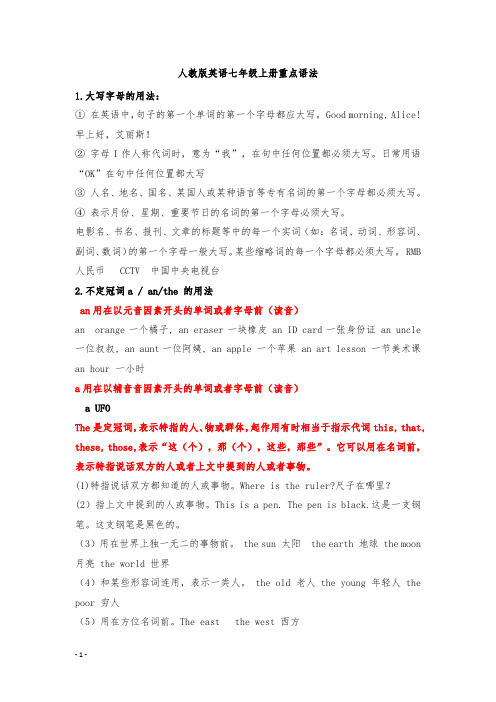
人教版英语七年级上册重点语法1.大写字母的用法:①在英语中,句子的第一个单词的第一个字母都应大写。
Good morning, Alice! 早上好,艾丽斯!②字母I作人称代词时,意为“我”,在句中任何位置都必须大写。
日常用语“OK”在句中任何位置都大写③人名、地名、国名、某国人或某种语言等专有名词的第一个字母都必须大写。
④表示月份、星期、重要节日的名词的第一个字母必须大写。
电影名、书名、报刊、文章的标题等中的每一个实词(如:名词、动词、形容词、副词、数词)的第一个字母一般大写。
某些缩略词的每一个字母都必须大写。
RMB 人民币 CCTV 中国中央电视台2.不定冠词a / an/the 的用法an用在以元音因素开头的单词或者字母前(读音)an orange一个橘子, an eraser一块橡皮 an ID card一张身份证 an uncle 一位叔叔, an aunt一位阿姨, an apple 一个苹果 an art lesson 一节美术课an hour 一小时a用在以辅音音因素开头的单词或者字母前(读音)a UFOThe是定冠词,表示特指的人、物或群体,起作用有时相当于指示代词this, that, these, those,表示“这(个),那(个),这些,那些”。
它可以用在名词前,表示特指说话双方的人或者上文中提到的人或者事物。
(1)特指说话双方都知道的人或事物。
Where is the ruler?尺子在哪里?(2)指上文中提到的人或事物。
This is a pen. The pen is black.这是一支钢笔。
这支钢笔是黑色的。
(3)用在世界上独一无二的事物前。
the sun 太阳 the earth 地球 the moon 月亮 the world 世界(4)和某些形容词连用,表示一类人。
the old 老人 the young 年轻人 the poor 穷人(5)用在方位名词前。
七年级上册英语考试知识点

七年级上册英语考试知识点
七年级上册英语考试的知识点包括但不限于以下几个方面:
1、字母和单词:英语的基本构成元素是字母,学生需要掌握26个英文字母的大小写形式以及它们的读音。
此外,学生还需要学习和掌握一定数量的单词,包括名词、动词、形容词等,并能够正确拼写和运用这些单词。
2、语法:七年级上册的英语语法主要包括基本句型、时态、语态、主谓一致等。
学生需要学习和掌握这些语法规则,并能够在实际的句子中正确运用。
3、听力:听力是英语学习的重要部分,学生需要能够通过听力理解简单的对话和短文,并能够从中提取关键信息。
4、口语:口语是英语学习中必不可少的一部分,学生需要能够运用所学单词和语法规则进行简单的对话和交流。
5、阅读:学生需要能够阅读简单的英语文章,理解文章大意,并能够回答与文章相关的问题。
6、写作:学生需要能够运用所学单词和语法规则进行简单的英语写作,包括描述、叙述等。
以上是七年级上册英语考试的一些主要知识点,但具体考试内容可能因不同地区使用的不同教材版本有所差异。
建议学生根据所在地区和学校的要求,结合教材和老师的指导进行针对性的复习。
七年级上册英语知识点归纳

七年级上册英语知识点归纳一、词汇(一)名词1、人名:如 Mike,Alice 等。
2、家庭成员:father,mother,sister,brother 等。
3、学习用品:pencil,eraser,ruler,book 等。
4、水果:apple,banana,orange 等。
5、颜色:red,blue,green 等。
6、服装:shirt,skirt,trousers 等。
(二)动词1、 be 动词:am,is,are2、实义动词:like,have,play 等(三)形容词1、 good,nice2、 big,small(四)代词1、人称代词:I,you,he,she,it,we,they2、物主代词:my,your,his,her,its,our,their二、语法(一)一般现在时1、表示经常发生的动作或存在的状态。
2、当主语是第三人称单数时,动词要用第三人称单数形式。
例如:He likes apples 而当主语不是第三人称单数时,动词用原形。
如:I like bananas(二)名词的单复数1、一般情况下,直接在名词后加 s。
如:book books2、以 s,x,ch,sh 结尾的名词,加 es。
如:box boxes3、以辅音字母+ y 结尾的名词,把 y 变为 i 再加 es。
如:family families(三)形容词性物主代词形容词性物主代词用于修饰名词,表示所属关系。
如:my book(我的书),your pen(你的钢笔)(四)介词1、 in:表示“在里面”,如:in the bag(在书包里)2、 on:表示“在上面”,如:on the desk(在桌子上)三、句型(一)问候语1、 Hello! / Hi! (你好!)2、 Good morning / afternoon / evening! (早上好/下午好/晚上好!)(二)自我介绍1、 I'm (我是)2、 My name is (我的名字是)(三)询问物品1、 What's this / that? (这/那是什么?)It's a / an (它是一个)2、 Are these / those?(这些/那些是吗?)Yes, they are / No, they aren't (是的,它们是。
人教版初一上册英语知识点归纳总结

人教版初一上册英语知识点归纳总结一、词汇1、人称代词主格:I(我)、you(你/你们)、he(他)、she(她)、it(它)、we(我们)、they(他们/她们/它们)宾格:me(我)、you(你/你们)、him(他)、her(她)、it (它)、us(我们)、them(他们/她们/它们)2、指示代词this(这个)、that(那个)、these(这些)、those(那些)3、物主代词形容词性物主代词:my(我的)、your(你的/你们的)、his(他的)、her(她的)、its(它的)、our(我们的)、their(他们的/她们的/它们的)名词性物主代词:mine(我的)、yours(你的/你们的)、his(他的)、hers(她的)、its(它的)、ours(我们的)、theirs(他们的/她们的/它们的)4、数字基数词:one(一)、two(二)、three(三)、four(四)、five (五)、six(六)、seven(七)、eight(八)、nine(九)、ten (十)、eleven(十一)、twelve(十二)、thirteen(十三)、fourteen (十四)、fifteen(十五)、sixteen(十六)、seventeen(十七)、eighteen(十八)、nineteen(十九)、twenty(二十)、thirty(三十)、forty(四十)、fifty(五十)、sixty(六十)、seventy(七十)、eighty(八十)、ninety(九十)、hundred(百)序数词:first(第一)、second(第二)、third(第三)、fourth(第四)、fifth(第五)、sixth(第六)、seventh(第七)、eighth(第八)、ninth(第九)、tenth(第十)、eleventh(第十一)、twelfth(第十二)、thirteenth(第十三)、fourteenth(第十四)、fifteenth(第十五)、sixteenth(第十六)、seventeenth(第十七)、eighteenth(第十八)、nineteenth(第十九)、twentieth(第二十)5、颜色red(红色)、yellow(黄色)、green(绿色)、blue(蓝色)、black(黑色)、white(白色)、purple(紫色)、brown(棕色)、orange(橙色)6、家庭成员father(父亲)、mother(母亲)、parent(父母)、grandfather(祖父/外祖父)、grandmother(祖母/外祖母)、grandparent(祖父母/外祖父母)、sister(姐妹)、brother(兄弟)7、学习用品pen(钢笔)、pencil(铅笔)、book(书)、eraser(橡皮)、ruler(尺子)、pencil box(铅笔盒)、schoolbag(书包)8、水果apple(苹果)、banana(香蕉)、strawberry(草莓)、orange(橙子)9、球类basketball(篮球)、soccer(足球)、volleyball(排球)、tennis (网球)、pingpong(乒乓球)10、食品hamburger(汉堡包)、icecream(冰淇淋)、salad(沙拉)、strawberry(草莓)二、语法1、一般现在时定义:表示经常发生的动作或存在的状态。
最新人教版初一七年级英语上册期末重要知识点及语法笔记总结归纳整理打印版可编辑
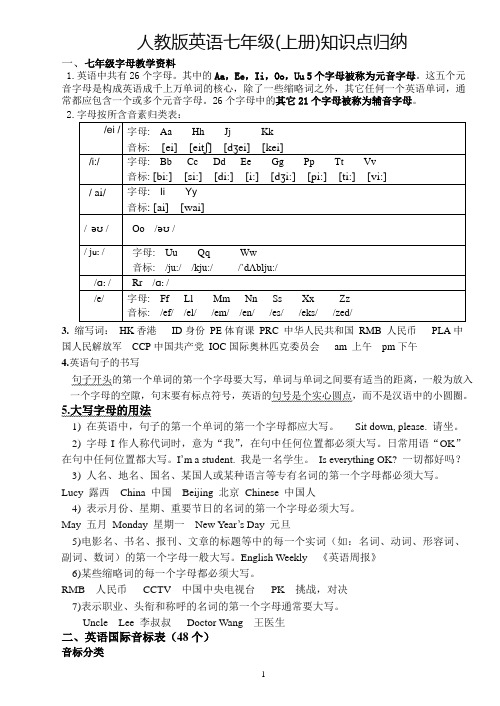
人教版英语七年级(上册)知识点归纳一、七年级字母教学资料1.英语中共有26个字母。
其中的Aa,Ee,Ii,Oo,Uu 5个字母被称为元音字母。
这五个元音字母是构成英语成千上万单词的核心,除了一些缩略词之外,其它任何一个英语单词,通常都应包含一个或多个元音字母。
26个字母中的其它21个字母被称为辅音字母。
3.缩写词:HK香港ID身份PE体育课PRC 中华人民共和国RMB 人民币PLA中国人民解放军CCP中国共产党IOC国际奥林匹克委员会am 上午pm下午4.英语句子的书写句子开头的第一个单词的第一个字母要大写,单词与单词之间要有适当的距离,一般为放入一个字母的空隙,句末要有标点符号,英语的句号是个实心圆点,而不是汉语中的小圆圈。
5.大写字母的用法1) 在英语中,句子的第一个单词的第一个字母都应大写。
Sit down, please. 请坐。
2) 字母I作人称代词时,意为“我”,在句中任何位置都必须大写。
日常用语“OK”在句中任何位置都大写。
I’m a student. 我是一名学生。
Is everything OK? 一切都好吗?3) 人名、地名、国名、某国人或某种语言等专有名词的第一个字母都必须大写。
Lucy 露西China 中国Beijing 北京Chinese 中国人4) 表示月份、星期、重要节日的名词的第一个字母必须大写。
May 五月Monday 星期一New Year’s Day 元旦5)电影名、书名、报刊、文章的标题等中的每一个实词(如:名词、动词、形容词、副词、数词)的第一个字母一般大写。
English Weekly 《英语周报》6)某些缩略词的每一个字母都必须大写。
RMB 人民币CCTV 中国中央电视台PK 挑战,对决7)表示职业、头衔和称呼的名词的第一个字母通常要大写。
Uncle Lee 李叔叔Doctor Wang 王医生二、英语国际音标表(48个)音标分类三、区别元音字母Aa,Ee,Ii,Oo,Uu 与元音二十个音素。
七年级上册英语考点集萃
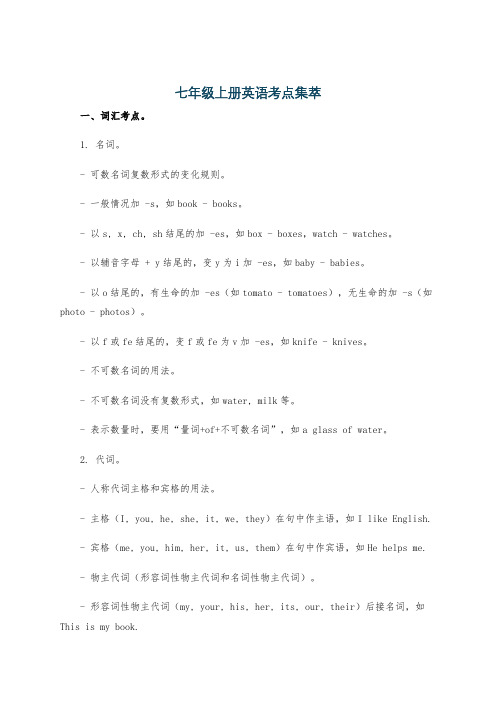
七年级上册英语考点集萃一、词汇考点。
1. 名词。
- 可数名词复数形式的变化规则。
- 一般情况加 -s,如book - books。
- 以s, x, ch, sh结尾的加 -es,如box - boxes,watch - watches。
- 以辅音字母 + y结尾的,变y为i加 -es,如baby - babies。
- 以o结尾的,有生命的加 -es(如tomato - tomatoes),无生命的加 -s(如photo - photos)。
- 以f或fe结尾的,变f或fe为v加 -es,如knife - knives。
- 不可数名词的用法。
- 不可数名词没有复数形式,如water, milk等。
- 表示数量时,要用“量词+of+不可数名词”,如a glass of water。
2. 代词。
- 人称代词主格和宾格的用法。
- 主格(I, you, he, she, it, we, they)在句中作主语,如I like English.- 宾格(me, you, him, her, it, us, them)在句中作宾语,如He helps me.- 物主代词(形容词性物主代词和名词性物主代词)。
- 形容词性物主代词(my, your, his, her, its, our, their)后接名词,如This is my book.- 名词性物主代词(mine, yours, his, hers, its, ours, theirs)相当于“形容词性物主代词+名词”,可单独使用,如The book is mine.3. 动词。
- 动词的第三人称单数形式变化规则。
- 一般情况加 -s,如like - likes。
- 以s, x, ch, sh, o结尾的加 -es,如go - goes,do - does。
- 以辅音字母 + y结尾的,变y为i加 -es,如fly - flies。
- 动词be(am/is/are)的用法。
- 1、下载文档前请自行甄别文档内容的完整性,平台不提供额外的编辑、内容补充、找答案等附加服务。
- 2、"仅部分预览"的文档,不可在线预览部分如存在完整性等问题,可反馈申请退款(可完整预览的文档不适用该条件!)。
- 3、如文档侵犯您的权益,请联系客服反馈,我们会尽快为您处理(人工客服工作时间:9:00-18:30)。
初一英语上册期末考试知识点总结初一上册(英语书)1-6单元总结知识点.重点句型StarterGood morning/afternoon/evening.Good morning/afternoon/evening.How are you? I'm fine,/OK,thanks. Fine,thanks.What's this in English? It's a map. It's V.Spell it please. K-E-Y.What color is it/the key? It's blue. The key is yellow. Hello, Frank. Hello/Hi, Eric.Unit 1 My name is Gina.I.重点句型What's your name? My name is Jenny. /I'm Jenny. /Jenny. Nice to meet you. Nice to meet you , too.What's his name? His name is Jenny. Jenny.What's her name? Her name is Linda.. Linda.What's your first name? My first name is Jack. Jack.What's your last/family name?My last/family name is Green. It's Green.What's your/his/her phone number?My /His/Her phone number is 234-4567. /It's 281-9176. II.词组1 name's=name is 名字是2 I'm=I am 我是3 she's=she is 她是he's=he is 他是you're =you are 你是(复数形式)they're=they are 他(她;它)们是that's=that is 那是isn't=is not 不是(单数形式)he's not =he is not=he isn't 他不是what's=what is 什么是where's=where is 在哪儿是Let's=Let us 让我们4 Nice to meet/see you 见到你很高兴5 last name=family name=surname 姓氏6 first name = given name 名字7 telephone number 电话号码=phone number 电话号码8 ID card 身份证9 Good morning (to sb) 早上好10 Good afternoon 下午好11 Good night /evening . 晚上好12 Sit down, please. =Have a seat, please. 请坐13 That's all right. 好;行;不用谢;没关系That's right . 对的、正确的All right . 好的,行,好吧14 Not at all.=It's a/my pleasure.=That's OK.=You're welcome.=That's all right. 不用谢Unit 2 Is this your pencil?I.重点句型Is that/this/it your backpack? Yes, it is. No, it isn't . It's his backpack.This/That is my eraser.How do you spell it/pen? P-E-N.Call Allan at 486-67895 Call 685-6098 Call Mary. Phone # 235-7865.Is that your computer game in the lost and found case? Yes, it is. No, it isn't. II.词组1 pencil case 铅笔盒2 pencil sharpener 卷笔刀3 pen pal =pen friend 笔友4 Thank you. =Thanks . 谢谢你5 in English 用英语6 computer game(s) 电子游戏7 Lost and Found 失物招领8 a set of 一副;一套a set of keys 一串钥匙9 who's=who is 谁是11 it's=it is 它是12 look at 朝…看13 ball-point pen 圆珠笔14 call sb at+电话号码打电话给某人15 gold ring 金戒指16 school ID card 校卡17 See you later.=See you soon . 再见Unit 3 This is my sister.I.重点句型That/This is his sister.These/Those are my two brothers.Is she your friend? Yes, she is. No, she isn't. Is he your brother? Yes, he is. No, he isn't. Thanks for the photo of your family.Here is my family photo.Who's your sister? This/She is my sister. II.词组1 Thanks for...+n./doing sth 为…而感谢2 pen friend 笔友3 aren't=are not 不是(复数形式)4 Thanks for your help 为了感谢你的帮助5 in the picture 在图中6 look at 朝…看7 talk about 谈论关于8 family photo 家庭照片9 family tree 家谱10 what about=how about 关于…怎么样11 draw a picture 画画12 a photo(picture) of …的一张照片13 on the back of the photo 在照片背后14 take photos (a photo) 拍照Unit 4 Where's my backpack?I.重点句型Where's my backpack? It's under the table.Where are your baseballs? They're on the floor.Is the baseball on the sofa? Yes ,it is. No, it isn't.I don't know.Are they on the bed? Yes, they are./ No, they aren't.Are these/those your books? Yes, they are. No, they aren't. Please take these things to your sister.Can you bring some things to school?The keys are in the drawer.Here's my room.II.词组1 in the drawer 在抽屉里2 don't=don not 不是(动词主语形式)3 in pair 成对的4 Goodbye.= Bye-bye 再见5 behind the computer 在电脑后面6 write down 写下;记下7 I'm sorry 对不起8 act out 表演出来9 alarm clock 闹钟10 video tape 录像带11 soccer ball 英式足球12 school bag 书包13 in the backpack 在书包里14 under the bed 在床下15 on the chair 在椅子上16 on the dresser 在梳妆台上17 math book 数学书18 take sth to…(there/him/+地点) 把…带去19 bring sth to …(here/me/+地点) 把…带来20 the math book 这本数学书21 the notebook 这个笔记本22 on the floor 在地上Unit 5 Do you have a soccer ball?I.重点句型Do you have a ping-pong ball?Yes, I do. No, I don't.Does he/she have a tennis racket?Yes, he/she does. No, he/she doesn't.Let's play ping-pong.It's boring.That sounds good/interesting.I don't have a ping-pong ball.He/She doesn't have a volleyball.She/He has a great sports collection.We have many sports clubs.He watches them on TV.Do you have some more paper? Yes, I do. /No, I don't. II.词组1 tennis racket 网球拍2 baseball bat 棒球球拍3 doesn't=does not 不是(动词三单形式)4 watch TV 看电视5 have /play/do sports 做运动6 a good idea 一个好主意7 every day/morning/Sunday/… 每天/每个早上/…8 watch a game(s) 看比赛/游戏9 like doing 喜欢做某事(爱好)10 like to do 喜欢做某事(特定时间)11 a ping-pong bat 乒乓拍12 That sounds interesting(fun)/good/difficult/boring/relaxing.那听起来很有趣/好/困难/无聊/轻松。
